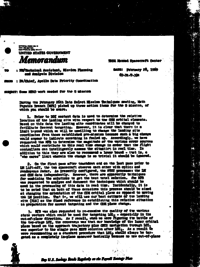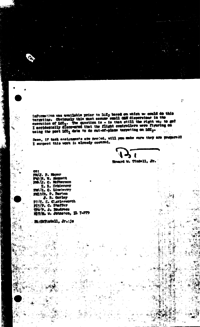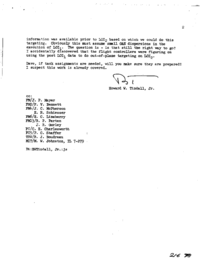FM/Technical Assistant, Mission Planning and Analysis DivisionFebruary 28, 196969-PA-T-39APA/Chief, Apollo Data Priority CoordinationSome MPAD work needed for the G mission
During the February 26th Data Select Mission Techninques meeting, Math Physics Branch (MPB) picked up three action items for the G mission, of which you should be aware.
1. Prior to DOI sextant data is used to determine the relative location of the landing site with respect to the CSM orbital elements. Based on this data the landing site coordinates will be changed to facilitate descent targeting. However, it is clear that there is a limit beyond which we will be unwilling to change the landing site coordinates from those established pre-mission because such a big change would appear to indicate something is fouled up. Accordingly, we have requested the MPB to determine the magnitude of the various error sources which would contribute to this real time change in order that the flight controllers can intelligently assess the situation in real time. In addition to this they are also to recommend a lower bound – that is, a “who cares” limit wherein the change is so trivial it should be ignored.
2. On the first pass after touchdown and on the last pass prior to LM lift-off, the two spacecraft observe each other with optics and rendezvous radar. As presently configured, the RTCC processes the LM and CSM data independently. However, there are apparently techniques for combining the solutions to get the best total solution. The MPB was requested to analyse and document the techniques which should be used in the processing of this data in real time. Incidentally, it is to be noted that on both of these occasions this process should be aimed at changing the orientation of the CSM orbital plane as opposed to moving the LM position. That is, we will use our best estimate of the landing site (RLS) as the fixed reference in establishing this relative situation in preparation for ascent targeting and the CSM plane change.
3. MPB was also requested to re-examine the quality of the various state vectors which could be used for targeting LOI₂ – especially in the out-of-plane direction. As I recall, when we were figuring the battle of the two-stage LOI, the consensus was that our knowledge of the lunar orbital plane based on the approach trajectory plus GNCS navigation through LOI₁ was superior to the single pass MSFN solution after LOI₁. As a result we were recommending as a standard procedure that LOI₂ should always be tar- geted as a completely in-plane maneuver basically because no new out-of-plane information was available prior to LOI₂ based on which we could do this targeting. Obviously this must assume small G&N dispersions in the execution of LOI₁. The question is – is that still the right way to go? I accidentally discovered that the flight controllers were figuring on using the post LOI₁ data to do out-of-plane targeting on LOI₂.
Dave, if task assignments are needed, will you make sure they are prepared? I suspect this work is already covered.
- Apr 04, 1969 – RLS Determination (4.1σ)
- Jun 07, 1968 – Some alternate ways of figuring out where the LM is on the moon will be available (3.6σ)




